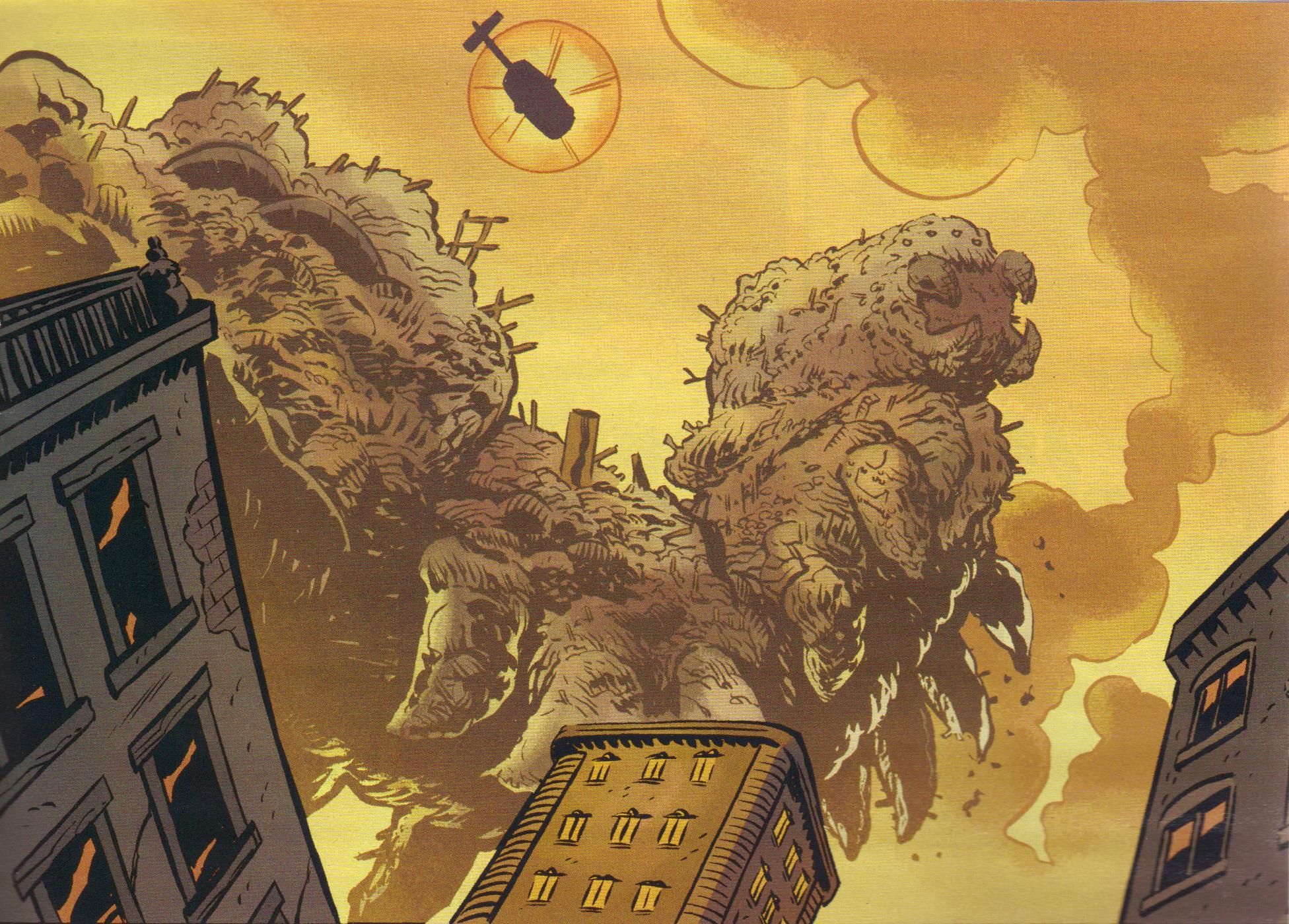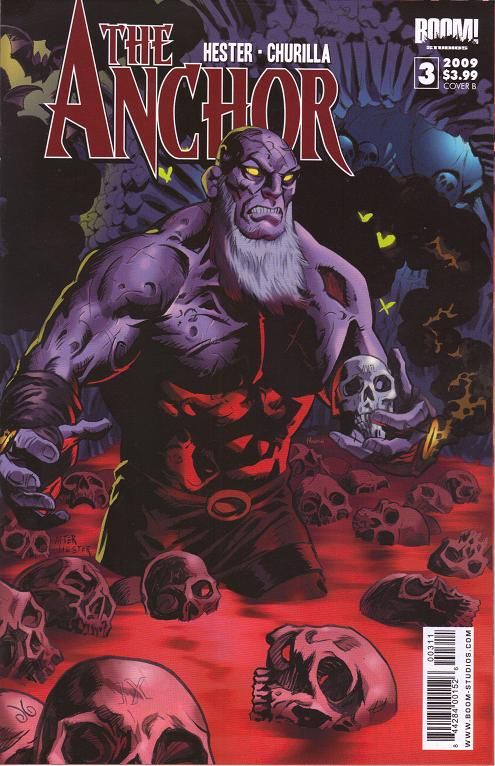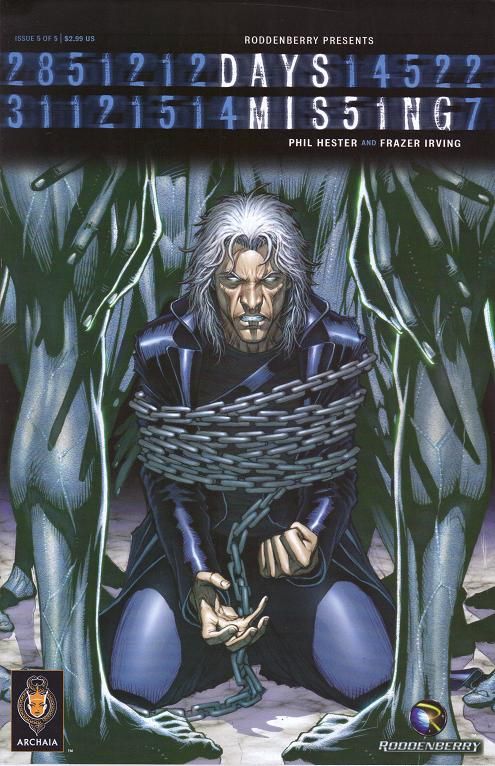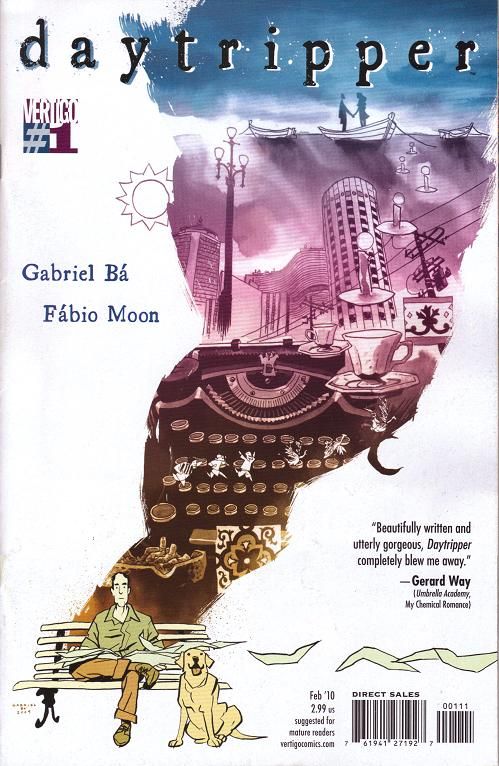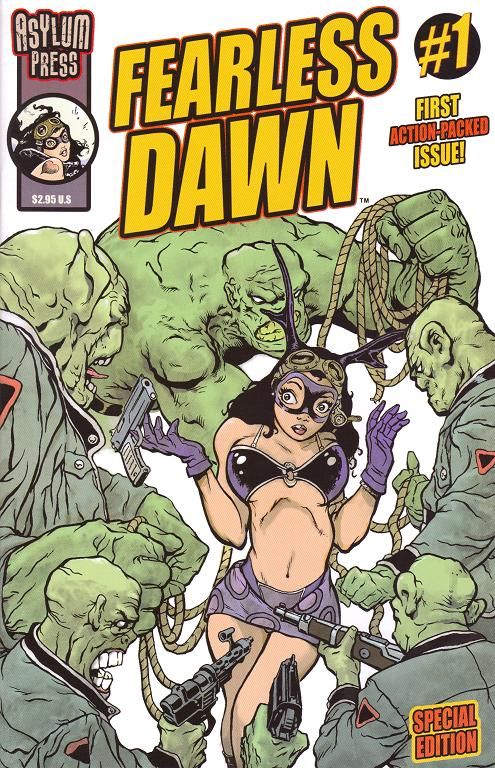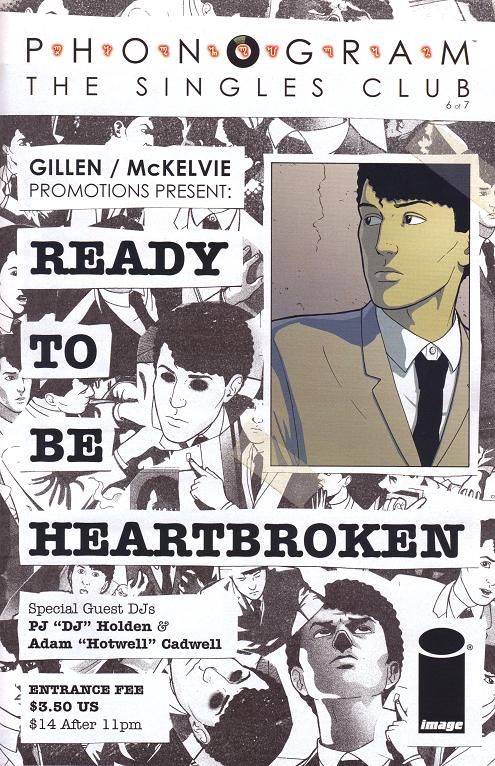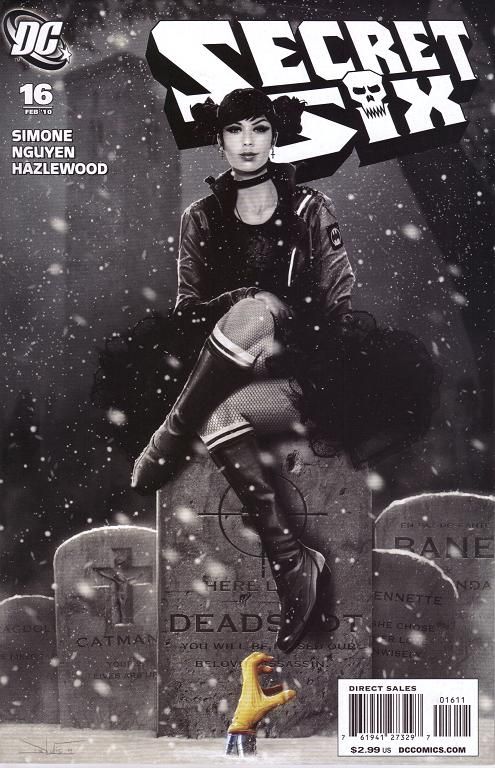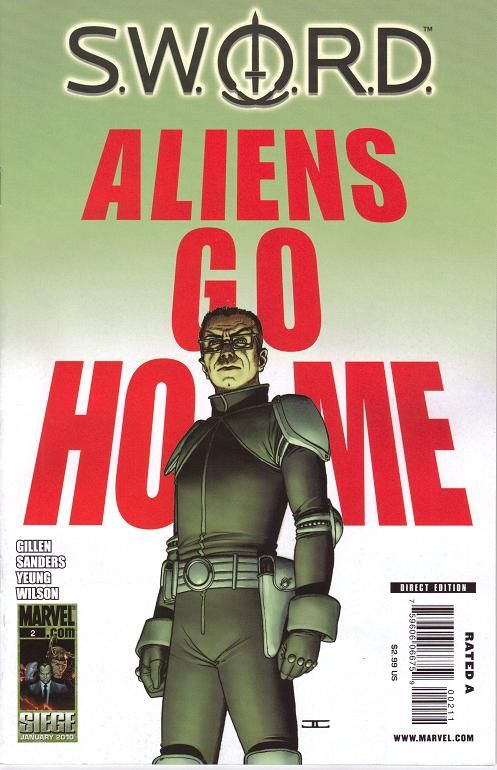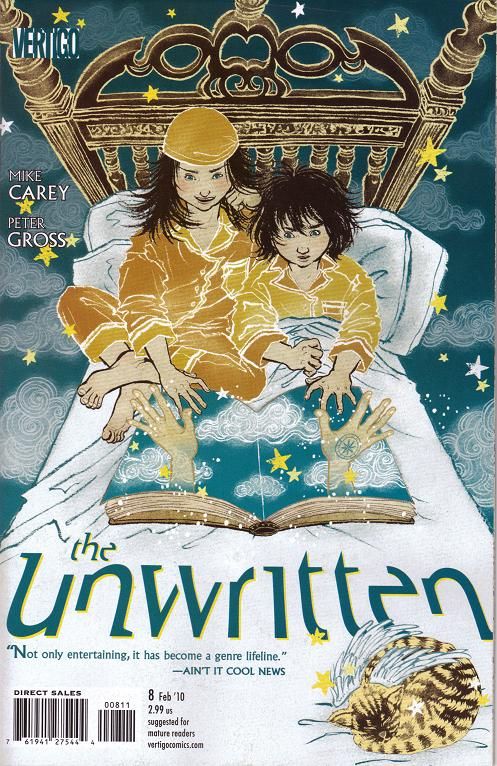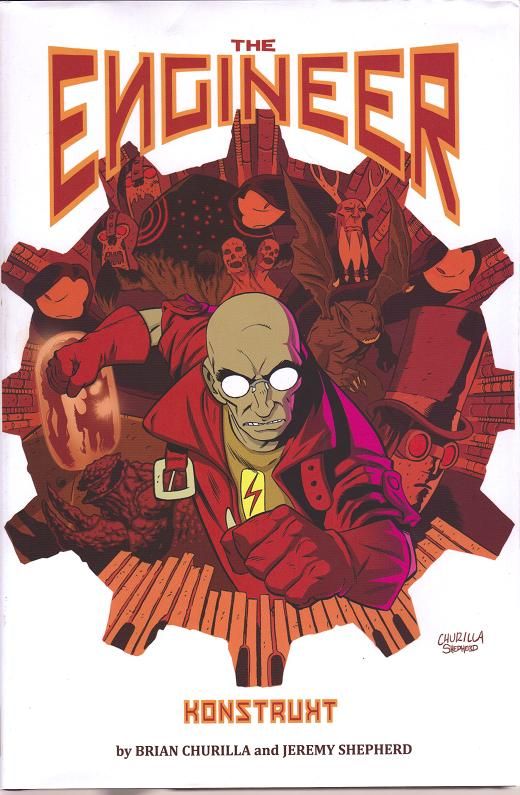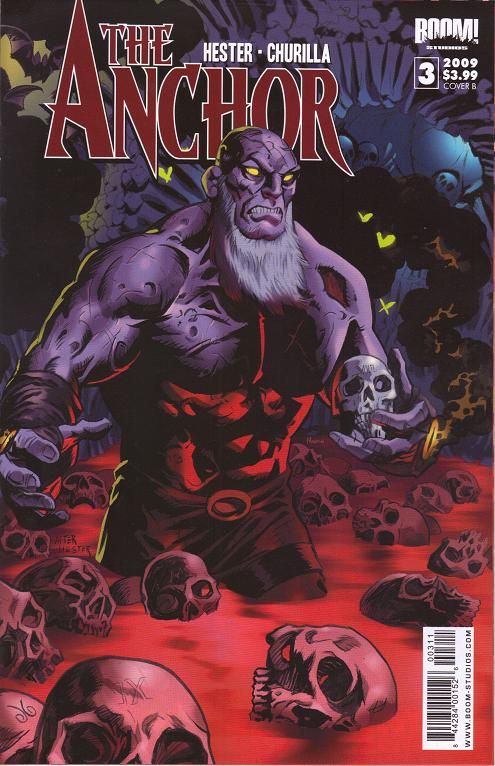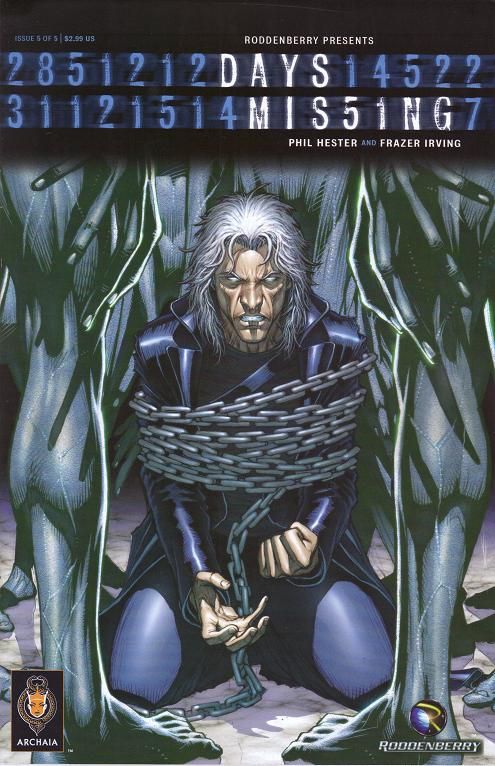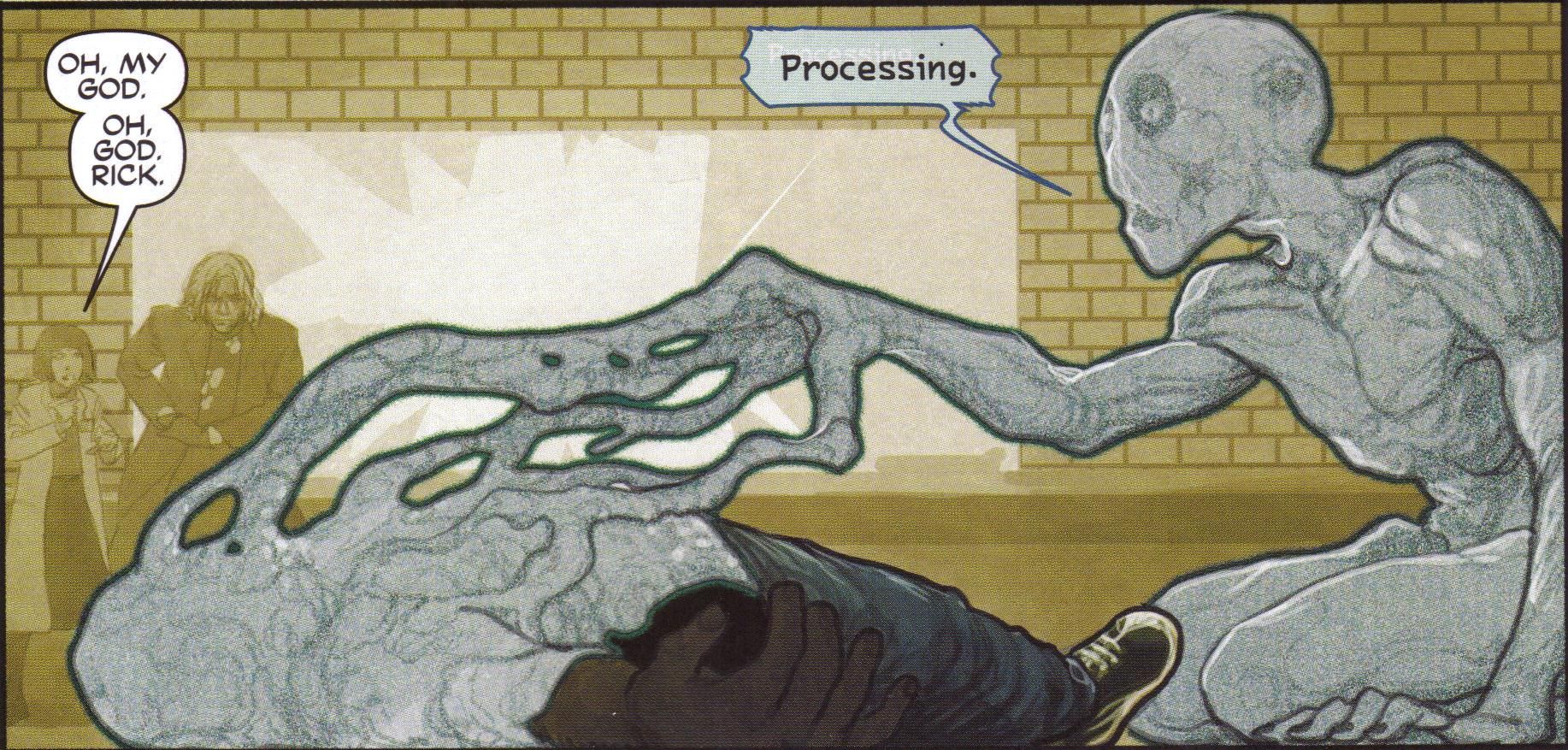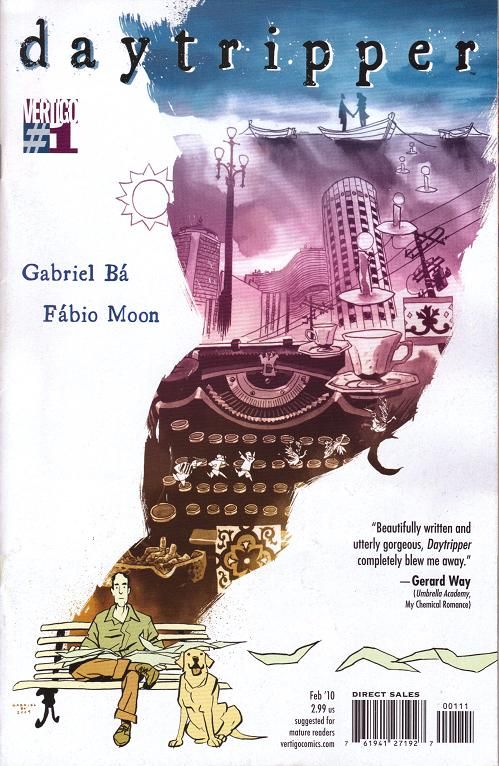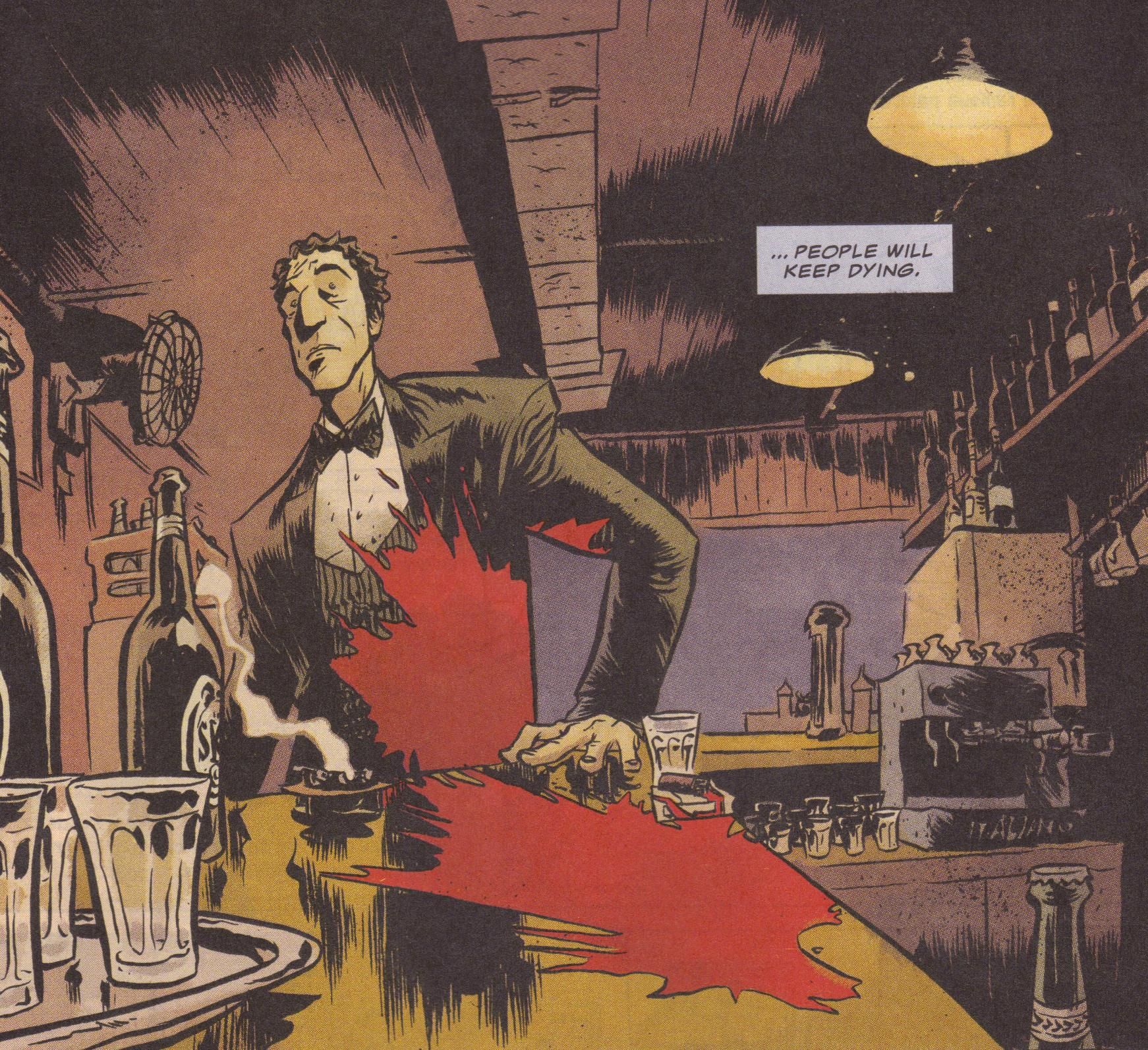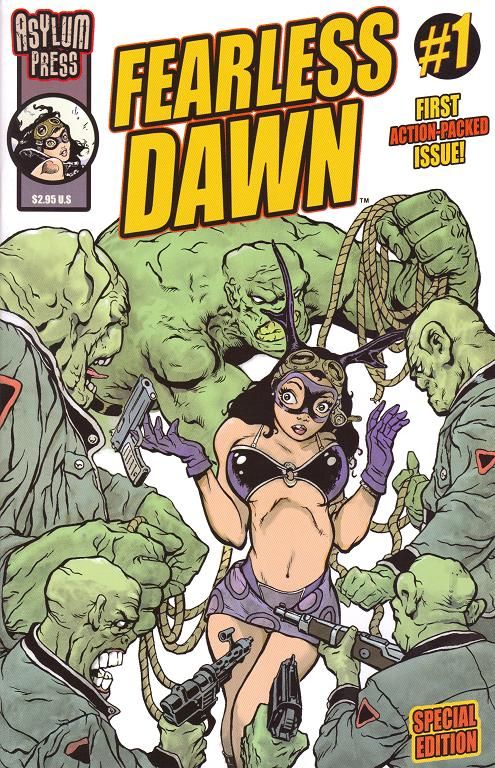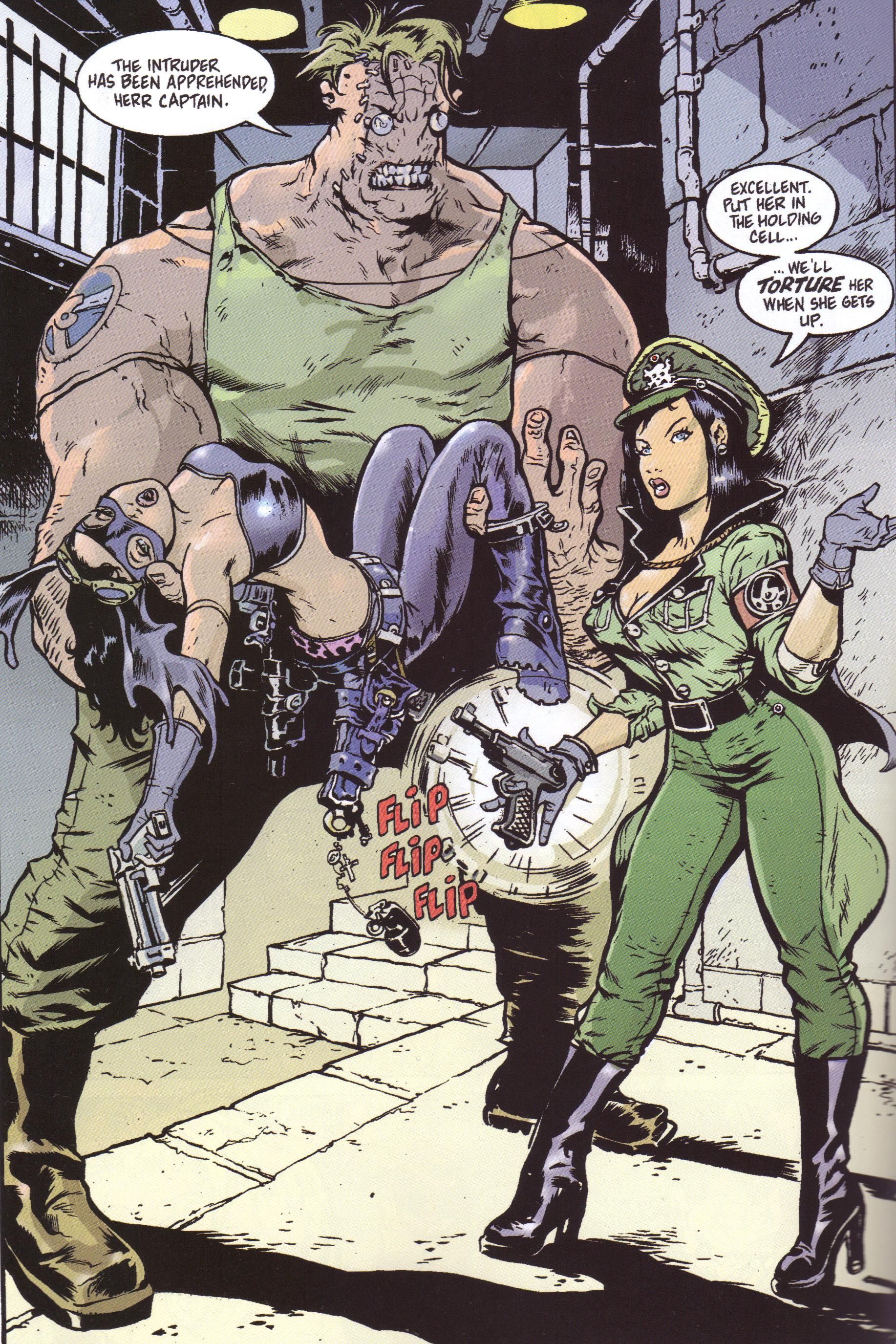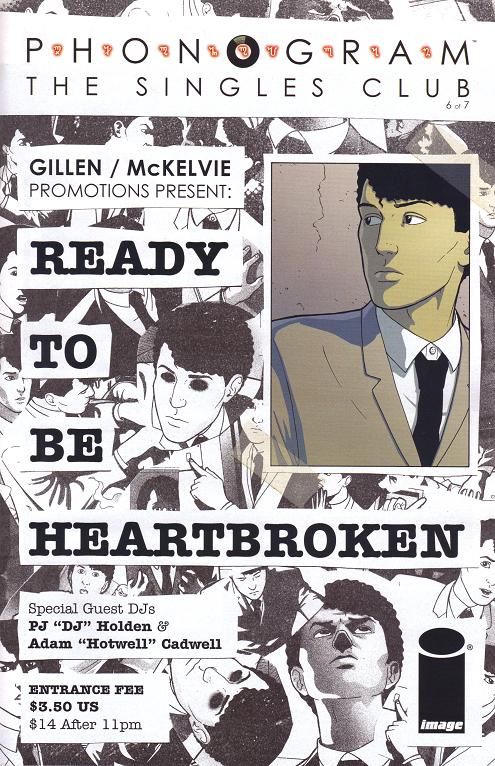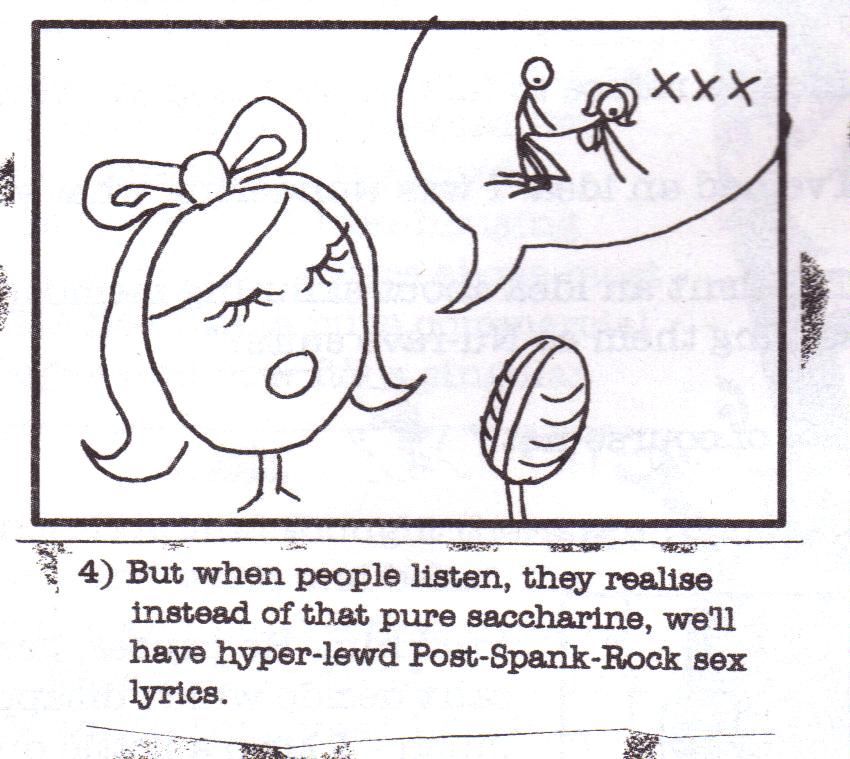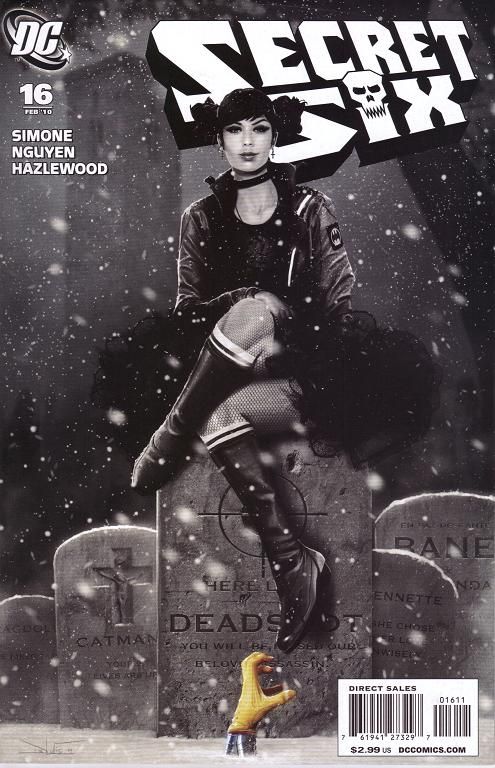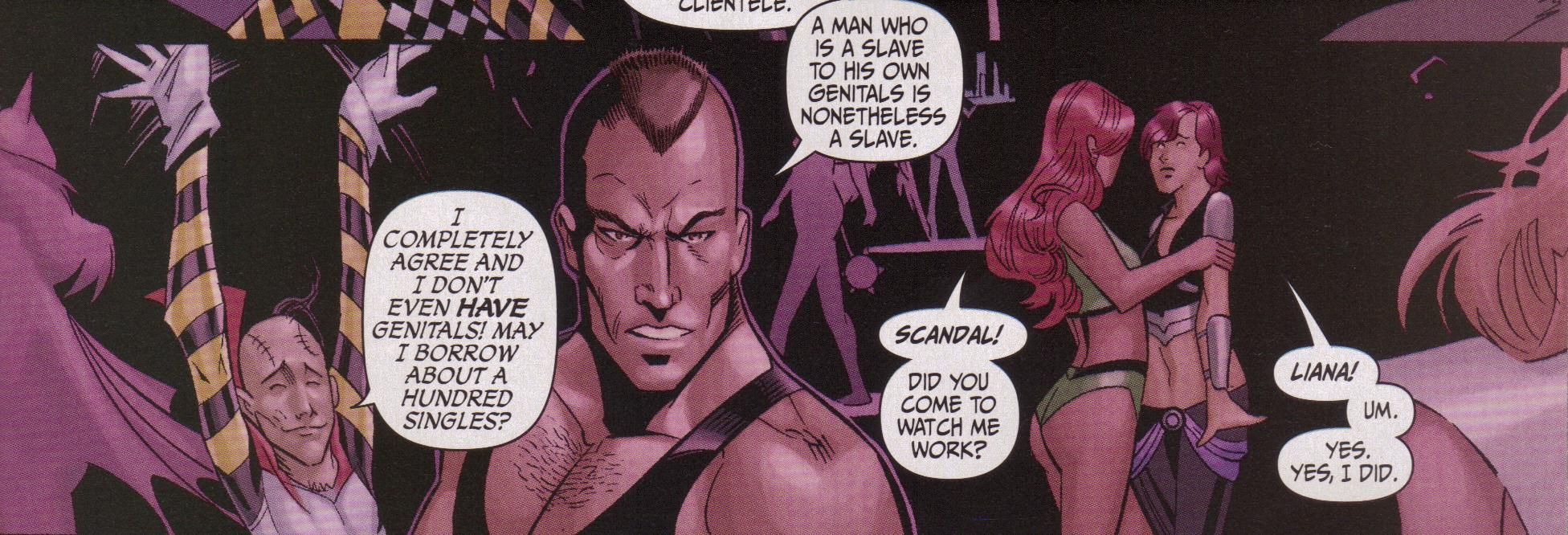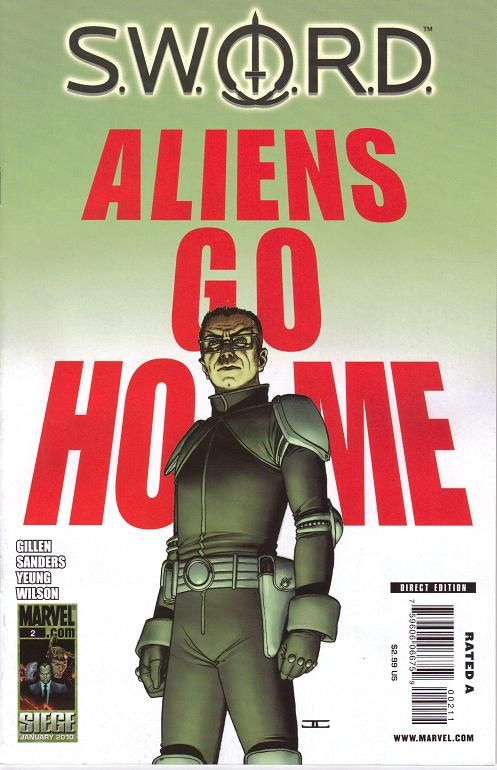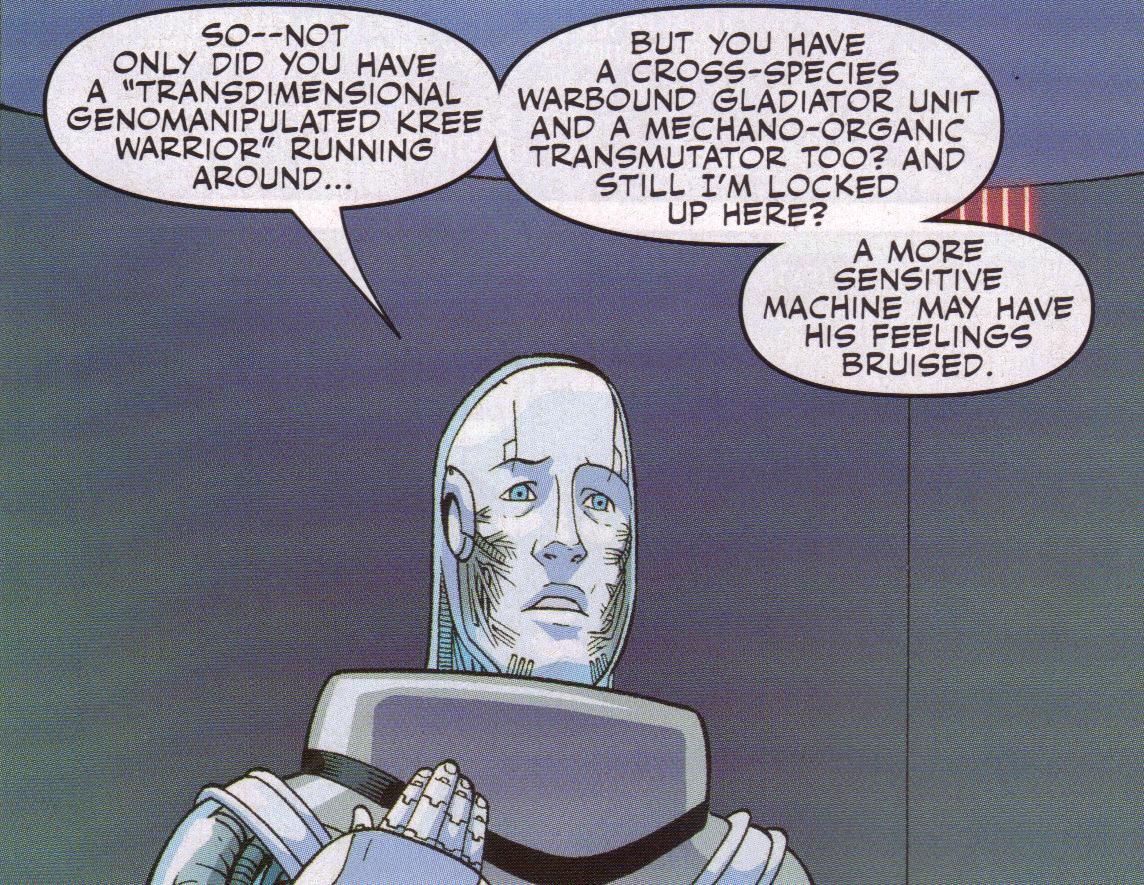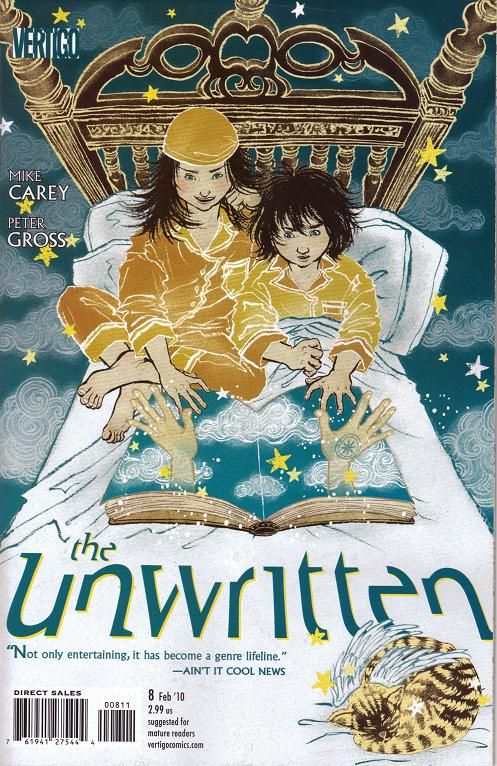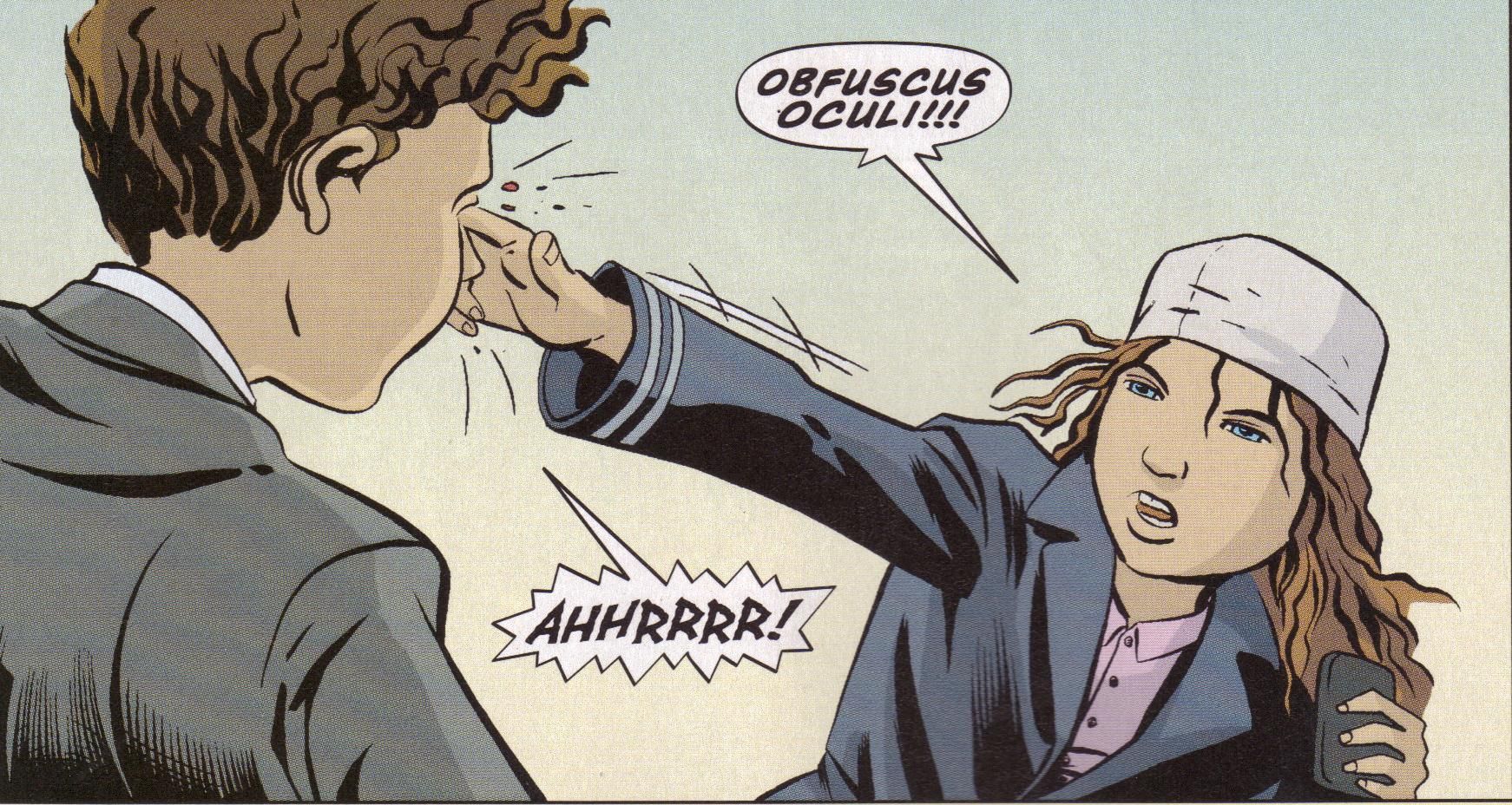Ay, I pray, leave me in my patience. You, that
Were ne'er possess'd of wealth, are pleas'd with want.
But give him liberty at least to mourn,
That in a field, amidst his enemies,
Doth see his soldiers slain, himself disarm'd,
And know no means of recovery.
Ay, let me sorrow for this sudden chance;
'Tis in the trouble of my spirit I speak:
Great injuries are not so soon forgot.
This week: Two books written by Phil Hester, two books written by Kieron Gillen, and THREE books colored by Matthew Wilson! Phew! Plus: Just to drive our pal Apodaca crazy, another installment of "Which song by a band that Dan hates is this comic?" But which band? See below!
The Anchor #3 ("Five Furies Part Three: The Unquiet Dead") by Phil Hester (writer), Brian Churilla (artist), Matthew Wilson (colorist), and Johnny Lowe (letterer). $3.99, 22 pgs, FC, Boom! Studios.
Hester continues his initial story, and it's still working pretty well. There are essentially two scenes in this book: The U. S. army experiments on the Anchor (he doesn't mind ... too much) and the Anchor fights a monster that animates the catacombs beneath the Vatican. Both are quite good. The government wants to determine how powerful Clem is, so they chuck all sorts of ordnance at him, attack him with bayonets, and finally pretend to put Hofi in danger to see how he reacts. He reacts the way they want him to (with violence), but then the news comes in from Italy that the catacombs have come to life, and Clem suggests that watching him beat on the bad guy is a good way for them to test him. Hester, however, comes up with a clever way for the Anchor to defeat the bad guy, because it's kind of hard to defeat a thing made out of skeletons and the hatred of the long dead. He also does a nice job in the beginning of the book, because the idea of the government being jerks is kind of dull, so Hester gives the soldiers who "attack" Clem some nice personalities, and Clem understands that they're just doing their jobs.
Churilla continues to do a fine job, as the creature made up of the catacombs is very cool, and the monster at the heart of it is revealed nicely. And he channels his inner Kirby on the splash page, which is neat.
As always, I'm on the fence with a new series until the first arc is finished, but so far, Hester and Churilla are building a nice little world here, full of interesting characters. We'll see how they wrap things up, as I believe next issue finishes the initial arc.
Which Marillion song is this comic? I'm going to go with "Forgotten Sons," which is an anti-war song. It seems to fit Clem's dilemma.
One panel of awesome:
Days Missing #5 (of 5) ("January 3rd, 2009") by Phil Hester (writer), Frazer Irving (artist), and Troy Peteri (letterer). $2.99, 22 pgs, FC, Archaia/Roddenberry Productions.
I'm not sure how I feel about this series, because I enjoyed it, but I have a feeling the creators could have done some more with it. Hester finally gets to some of the machinations behind the scene in regard to the Steward, as the narrator of this issue is someone who knows what he's doing and is apparently trying, in some way, to thwart him. I know there's supposed to be a sequel, but it seems like the people behind the series could have brought in the grand story a bit sooner, because each issue has been constructed as a single-issue story, and while there's something to be said for single-issue stories, I'm not sure it was the way to go with this. Given that each issue was by a different creative team (except for this one, which has the writer and artist from issue #1 back), it seems like adding in a bit of a bigger epic behind what the Steward was doing might have been a way to keep people reading if they didn't like one of the writers or one of the artists and thought they could skip that issue. Maybe nobody did that and if they bought issue #1 they kept buying it and if they didn't buy issue #1 they didn't buy any of it, but it's a bit frustrating to reach the end of the mini-series and realize that we're pretty much at the beginning of the story. What the Steward does isn't that difficult to grasp, so five issues to establish it probably wasn't necessary.
Man, I'm ragging on Archaia's mini-series recently, aren't I, what with this one this week and The Secret History last week. Just like that one, however, there's nothing wrong with this individual issue - Hester does a nice job with the story of a nanomachine that gains sentience and becomes a monster that will devour the galaxy if it's not stopped, and Irving, of course, draws the hell out of it. It's a pretty verbose issue, but Hester keeps the pseudo-science believable and does a very good job with the resolution (yes, he did a nice job with the resolution in The Anchor, too - unlike some writers, Hester can set things up AND end them well). He also does a fine job with the characters, who of course haven't existed until this issue and so need to get personalities quickly. And I wish Irving did more work. Dang, he's good.
I'm curious to see what the next mini-series will look like. I don't know if Archaia is going to do the same thing with the different creators or if they're going to stick with one creative team. But Hester has done a nice job setting it up - now they have to follow through!
Which Marillion song is this comic? "Man of a Thousand Faces." "You see my face in the stones of the Parthenon / You hear my song in the babble of Babylon ..." That works!
One panel of awesome:
Daytripper #1 (of 10) ("32") by Fábio Moon and Gabriel Bá (writers/artists), Dave Stewart (colorist), and Sean Konot (letterer). $2.99, 22 pgs, FC, DC/Vertigo.
Moon signs the final page with a 2008 date, so this has been in the works for quite some time. I just thought you should know that.
So Daytripper begins, and if you've read any Vertigo book in the past few months, you've seen all the press for it. Based solely on the art of the twins, this is a must-buy, but how would they do with the writing? I've only read one thing by Moon and Bá, and while it was okay (it was a chapter in Pixu, if you must know), I still don't know how their ten-issue extravaganza will play out. But it's off to a pretty decent start.
Bá and Moon tell a short story about Brás de Oliva Domingos, an obituary writer in São Paulo whose birthday it is (hence the title of this story). It's also the night his father, a famous writer, is honored by the citizenry, and so everyone forgets it's Brás's birthday. It's so Molly Ringwald! The brothers begin the story at the end, with Brás in a bar covered in blood. Oh dear. That can't end well. Then we get a flashback to his day, and how it leads to the bar. Moon and Bá ruminate on the meaning of family and why we stick with them, but they also show how each small decision leads to bigger and possibly tragic ones (Brás, remember, is covered in blood). There's a lot of nice writing here, as the twins don't push the themes too much, but by the end, we get a sense of loss and unfulfilled potential and a yearning to escape what we're born into. It's a fairly subtle comic, even if the final words are a bit too portentous.
Moon draws it, but I'm not sure what the plan is for the entire series. Will they switch off? How much did Bá do on this issue? It's obviously Moon, because his pencils are a bit rougher than Bá's (plus, you know, he signed it, but even before that, it's easy to see the difference in style), but the credits simply list them together. It doesn't really matter, I suppose, because they're both so freakin' good.
I'm sure there will plenty of people waiting for the trade on this one, and that's cool. I'll be here to remind you that it's good. Okay, I'll be here to remind you that this issue is good. I can't speak for the rest, as they haven't come out yet. That would be a pretty keen talent to have, wouldn't it?
Which Marillion song is this comic? The way Brás moves through the day reminds me a "That Time of the Night." Yes, I'm aware of the irony in that statement. Deal with it.
One panel of awesome:
Fearless Dawn #1 (of 4) by Steve Mannion (writer/artist). $2.95, 22 pgs, FC, Asylum Press.
Prior to this week, I had never read a Steve Mannion comic. Now, I've read one of his trade paperbacks, The Bomb (a review of which is forthcoming), and this, the first issue of a new mini-series starring his cheesecake superheroine, Fearless Dawn. If you're a Mannion fan, it's an embarrassment of riches!
I'll get into Mannion's art style, which is kind of Mad-magazine crossed with Dave Stevens, when I review The Bomb. This issue brings back some characters from that series, including our title heroine and her nemeses, who are Nazis. Mannion likes his Nazis! One thing he does is age Fearless Dawn, which is interesting because in her first appearances, she seemed like a jailbait teenager, and there's a certain skeeviness factor to reading about her (even though Mannion keeps the comic clean and there's a bit of a refreshing, 1940s-innocent vibe to the cheesecake). This issue begins "16 years later," so ogle away, gents, she's legal!
In this comic, Dawn is apparently a secret agent (whereas in the previous series she was just someone who fought evil), and she goes off on a mission to Manitoba to stop General Fritz and Helga von Krause from creating a drug that makes soldiers berzerkers in combat. She gets captured, and Number 7, a tow-headed rugged fellow agent, comes to her rescue. Of course, he gets captured too, but Dawn has a crazy plan to escape! They do escape, but at what cost? AT WHAT COST?????
Obviously, the plot is a bit goofy. It's meant to be. This comic is basically an excuse for Mannion to draw a scantily-clad woman beat on big ugly Nazis while the sexy Nazi leader looks on. It's silly fun, and Mannion's art, I must say, is joyously wacky. There's really nothing socially redeeming about Fearless Dawn at all, but if you want a silly adventure with lots of action and its tongue planted firmly in its cheeks, you couldn't do a lot better. Although I do wonder about Dawn's tattoos, which seem to change from panel to panel and even switch arms at random. Oh well!
Which Marillion song is this comic? This is a tough one, because the tone of this comic is so silly. But "The Party" works a bit, mainly because of the transformation of Prissy Jones in Fearless Dawn, which doesn't happen in this issue. Oh well!
One panel of awesome:
Phonogram: The Singles Club #6 (of 7) ("Ready to be Heartbroken"/"Your Song"/"Atlantis to Interzone") by Kieron Gillen (writer), Jamie McKelvie (artist/letterer, "Ready to be Heartbroken"), Julia Scheele (art assist, "Ready to be Heartbroken"), PJ Holden (artist, "Your Song"), Adam Caldwell (artist, "Atlantis to Interzone"), Matthew Wilson (colorist, "Ready to be Heartbroken"), and Steven Denton (colorist, "Your Song"). $3.50, 27 pgs, FC, Image.
Gillen told me I should start the critical backlash against Phonogram by picking on Holden, who draws the first back-up story. But Holden is quite good, as is Caldwell, so no dice, KG!
Jamie McKelvie stopped by and explained that this would probably be the last series of Phonogram because it simply doesn't pay anything. Well, I'd just like to know who the hell said he deserved to eat? Don't we deserve great comics, Mr. McKelvie? Nut up, will you? Sheesh.
I implied in my pseudo-review that McKelvie didn't have a lot to do because a lot of this issue is text, which of course does a disservice to the brilliance of the art. I mean, in issue #4, McKelvie basically repeated the same panel for sixteen pages, and it was still excellent, wasn't it? So let's consider the art, because Gillen needs to be taken down a peg. Let's consider the first page, which is wordless. Lloyd comes home after his meeting with Laura at the end of issue #5, and he's grumpy because she punctured his grand scheme. He comes in, grumpy, closes the door and leans his head against it, and he switches to gloomy. Then, in the next panel, he becomes angry again. It's a wonderful sequence because it's something you can imagine easily, going from anger to despair and back to anger. As we learn more about Lloyd, it becomes clearer why he feels this way, but McKelvie makes it such a universal series that we don't need to know what's going on in Lloyd's head. Then Lloyd digs into his "grimoire" to update his grand scheme - he wants to construct songs out of snippets of early pop songs that are no longer under copyright so that they can become subtle sex songs and expose the hypocrisy of pop music, which is a typically Lloyd thing to do. McKelvie gives us a nifty little metafictional page that shows Lloyd as the most "phonomancer-ish" of these people - Lloyd, as David Kohl subtly points out, takes everything way too seriously, so McKelvie does a nice job showing just how magical he is. And then, when Lloyd finally realizes what Kohl was saying to him, he dances with pure joy, and McKelvie does a great job showing him, for once, just letting go - and we know it's a few hours too late, because he should have been that way with Penny at the club, but at least he's doing it now. The way McKelvie shows him listening to Los Campesinos! is excellent, as the lyrics slowly work their way into his head and lead to his epiphany. It's tremendous. Credit should also go to Wilson's colors (he does fine work on The Anchor and S.W.O.R.D., but let's look at it here, because it's fun). As the issue takes place at night but in that typical urban night where it's never completely dark, the "present" of the comic (six panels are in flashback to the club earlier in the evening) is lit in that kind of gray-green half-light that anyone who's ever been up at three in the morning recognizes. Most colorists, I suspect, would use standard blacks and grays to color the scene, but Wilson makes it even more unworldly (which three in the morning often is) with his choices, and his stark reds when Lloyd uses his powers stand out even more.
Oh, and Gillen is awesome as usual. Just the way Kohl points out that Lloyd should be dancing would make the issue worth it, but of course there's so much more than that. But that's all I'm saying about the writing!
I should point out that while I was looking for the creators' sites, I found a link on Julia Scheele's blog to How Fucking Romantic, on which each of Stephin Merritt's 69 love songs gets illustrated. If you've never heard 69 Love Songs, it's a brilliant, brilliant album (three, actually, with 23 songs on each) by one of Merritt's incarnations, The Magnetic Fields. The blog is extremely awesome and a nice companion to the album.
Which Marillion song is this comic? "A Few Words for the Dead." Lloyd isn't as out there as the subject of this song, but he could still take the advice offered!
One panel of awesome:
Secret Six #16 ("The Rabbit & the Grave") by Gail Simone (writer), Peter Nguyen (penciller), Doug Hazlewood (inker), Mark McKenna (inker), Jason Wright (colorist), and Travis Lanham (letterer). $2.99, 22 pgs, FC, DC.
This is a rare misstep in this series, as there's nothing all that worse than the previous fifteen issues, but something's off about it. I want to say it's the lack of more Ragdoll, as he's barely in the book but still adds a nice touch of levity. But even when everyone's favorite disjointed bad guy isn't around, the book still works, except in this issue. I think it's because there's not much point to it beyond getting Black Alice on the team. I have no problem with Black Alice being on the team, but it's kind of a convoluted way to get her on it when all she wants is to make money because her father's ill. Maybe the team wouldn't respect that? So she has to "prove" that she belongs, but this isn't the Justice League or anything, so can't they just take her on and kill her if she's a liability? I mean, they're villains, after all. I don't even know why we need a "How Black Alice gets on the team" story anyway. Can't we just show her hanging with the homeboys and explain it in a sentence or two and then get the reasons she wants to be there later? I don't know, it just seems pointless.
Which wouldn't be a problem if the writing and art were good, but they're not. This is an unpleasant issue even by Secret Six standards, as Lawton and Blake "rescue" a serial rapist/murderer who likes pre-teen girls only to turn him over to a victim's father, who plans to butcher him. Blake even gives him tips! Then, to ditch Black Alice, they take her to a strip club - I'm not sure why that would bother her, and I'm not sure why they would think it would. She's magical, so even if the club would balk at allowing a female in (which they wouldn't) or a teenager (which, given the way Nguyen draws her, they might not realize she is), she could easily get in. Then we get strippers dressed as various DC characters, which we've seen before in this book (this is apparently the club where Scandal's stripper crush works, although I don't recall the name of that club in the other issue), so I'm not opposed to it even if it is creepy - it's the kind of place Lawton and Blake WOULD go to, after all. The rest of the team shows up and there's kind of a half-hearted fight with Black Alice before she convinces them to let her join. Alice steals Jeannette's powers and turns into ... the Silver Banshee? I know that's what Jeannette looks like when she "turns," but it looks more obvious in this issue than when we've seen it before. Why does she look like the Silver Banshee? And how sad is it that I never read Superman books but I know who the Silver Banshee is?
So the writing isn't great, and Nguyen doesn't help. Actually, I can't blame him completely, because some of the pages look much sloppier than others, so I wonder if the particular inker wasn't doing Nguyen any favors. I don't know who inked what, but on some pages, the lines are much lighter and lack definition, while on others (the better ones, in my humble opinion), the inks are heftier and add depth and personality to the figures. It's still not as good as Nicola Scott's work, and I worry that now that Scott is off doing Blackest Night tie-ins she'll be too high-profile to return to the book. That would suck. She's not drawing the next two issues, but we'll see after that.
Simone and Ostrander ramp up the Suicide Squad story next, which should be pretty awesome. I'm not 100% sure, but I'm fairly confident this is just a minor bump in the road, because Simone has been doing so well up until now.
Which Marillion song is this comic? Black Alice could be a perfect "Cannibal Surf Babe," I reckon.
One panel of awesome:
S.W.O.R.D. #2 by Kieron Gillen (writer), Steven Sanders (penciler), Craig Yeung (inker), Matt Wilson (colorist), and Dave Lanphear (letterer). $2.99, 22 pgs, FC, Marvel.
Gillen doesn't waste any time with legal niceties, as Gyrich's plan to deport all aliens hits its stride in this issue, as Noh-Varr is snatched up on the first couple pages, and various others get potted throughout the issue, including Hepzibah (why the hell is she on Earth again?), which draws the ire of the X-Men and subsequently Beast, who doesn't like it one bit, rants to Abigail about it, and finds out that Gyrich is one step ahead of them. But that's a plot point for another day! The main story in this issue is Abigail, Beast, and Lockheed's rescue mission to get Abigail's half-brother, who has been snatched by Death's Head. While I don't recall Death's Head being so gigantic (granted, I don't know a whole hell of a lot about Death's Head), it's a nice fight issue, as our heroes try to figure out how to beat him. And, of course, they come to an accord with him, which doesn't last long. Death's Head must figure in the resolution of Gyrich's evil plan! I foresee it!
Plot-wise, this is nothing special (sorry, KG). Gyrich's blitzkrieg against aliens surely couldn't happen as easily as this, could it, and while Abigail's negotiated settlement with Death's Head is handled well, it doesn't really take us by surprise. As usual, the joy in this book comes from Gillen's dialogue, which is whipcrack smart and often hilarious. Death's Head is sufficiently arrogant and surprised that such tiny creatures could even cause him discomfort, much less escape his wrath, and while I'm not sure why McCoy is so smitten with a lady who yells at him constantly, Abigal's domineering attitude toward him is funny for the reading audience. And the Robot (does he have a name?) is rapidly becoming the Marvel Character Find of 2009 (there are so many good new characters these days that I have to break them down by company).
I guess I can live with Beast's weird appearance, and other than that, Sanders does a good job with the art, especially with Death's Head (I guess some people complained about his "redesign," but I don't care about that). He does a good job with Abigail, showing her going through various stages of peeved. It's neat.
Gillen might be feeling this out with regard to plot, but this is still a fun read. I'd rather read a comic with good characters and good dialogue and let the writer feel out the plot than vice versa. You may differ from me in that respect.
Which Marillion song is this comic? "Assassing." This is the height of Fish's really, really oblique lyrics, but it seems to work with Abigail and Gyrich both starring in this comic.
One panel of awesome:
The Unwritten #8 ("Inside Man: Interlude") by Mike Carey (writer), Peter Gross (artist), Chris Chuckry (colorist), Jeanne McGee (colorist), and Todd Klein (letterer). $2.99, 22 pgs, FC, DC/Vertigo.
Hey, it's the eighth issue of The Unwritten, which I decided to read and review even though I haven't actually read issue #7 yet! Yes, my comics shoppe still hasn't gotten it for me, but it's coming ... someday. No big deal. I can wait.
In the interim, this is a nice experiment to see if skipping a month makes any difference. I'm not sure what happened last time out, but we begin this issue with the new warden of the prison in which Tom Taylor is incarcerated. Claude Chadron's children love the Tommy Taylor books, and he encourages their make-believe play, which may or may not be the right thing to do, as becomes clear as the issue progresses. Chadron claims that his prison will be run according to impartial justice, but we see that this doesn't apply to Tom. Meanwhile, the kids get deeper and deeper into their fantasy world as Tommy's friends, which is difficult for Chadron. On the one hand, he desperately needs to believe in a world where good triumphs over evil and where kids are able to use their imaginations. On the other hand, he's upset that Tom Taylor is in his prison and what it might do to his children. It's fascinating how Carey goes through the book with Chadron. We think he's going to be a stereotypical mean prison warden who ignores corruption in his ranks in order to take it out on the prisoners, and he is ... to a degree. But Chadron obviously has experienced some trauma in his past that makes him yearn for an innocence he no longer possesses, to the point where his need for it in his children becomes almost pathological. It makes Chadron a much more interesting character than we originally think.
I'm not sure if this issue is running concurrently with issue #7, just from another point of view. It sort of has that feel to it. I guess I'll find out when I actually read issue #7. Until then, this is a nice issue that shows off Carey's writing skills. You don't necessarily have to know what's going on in the series, because Carey does a good job getting us into the story and it's an "interlude" anyway - we step outside the main story to get a look at how what's happening to Tom affects fans of the Tommy Taylor series. It's better to have read the rest of the series, but not completely necessary. That's not a bad trick!
Which Marillion song is this comic? "Beyond You" works both for Chadron AND his children, I think.
One panel of awesome:
So last week, in Friday's Arizona Republic, I saw this headline:
Man, they really ought to give it to him! He's a Norse god, for crying out loud! The interview process is so demeaning!
Last week, absolutely no one guessed the totally random lyrics, which were from "Tokyo Road," the epic Bon Jovi song from 1985's 7800° Fahrenheit. You know, when you people can't keep up with your hair metal band lyrics, what hope does Western civilization have? Sheesh. All right, let's fire up some more totally random lyrics!
"I used to have a girlfriend known as Elsie
With whom I shared four sordid rooms in Chelsea
She wasn't what you'd call a blushing flower ...
As a matter of fact she rented by the hour
The day she died the neighbors came to snicker:
"Well, that's what comes from too much pills and liquor"
You know you want to sing along!

